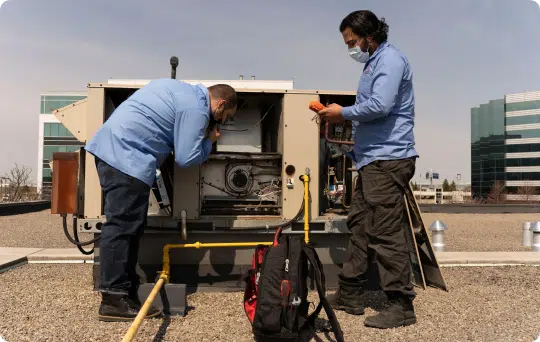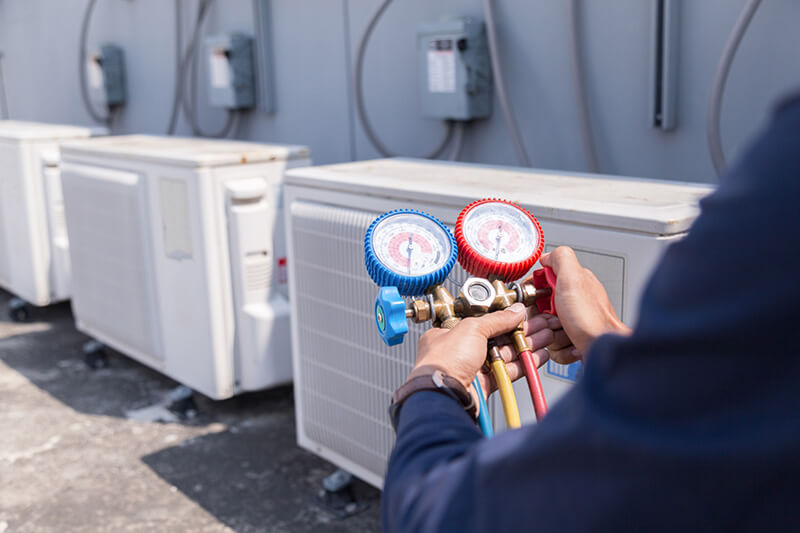Upgrade Tips to Make the Most of Your New furnace replacement
Upgrade Tips to Make the Most of Your New furnace replacement
Blog Article
How a Heatpump and Heating System Work With Each Other to Optimize Your Home's Heating Efficiency
Understanding just how a heatpump and furnace collaborate is crucial for home owners looking for reliable home heating solutions. Each system has its toughness, supplying a balanced strategy to home comfort. The heatpump masters moderate temperatures, while the heater supplies fast heat during extreme cold. This synergy not just decreases energy prices but also boosts the life-span of both home appliances. What aspects influence this collaboration, and exactly how can home owners maximize their advantages?
Recognizing Warm Pumps: Exactly How They Work
Although lots of people might be not familiar with their inner workings, heatpump play a necessary duty in contemporary heating unit. These gadgets run by moving warmth from one area to one more, utilizing the principles of thermodynamics. In colder months, a warm pump essences warm from the outdoors air, ground, or water, and transfers it indoors to warm up the space. Conversely, throughout warmer months, it can reverse the procedure, working as an a/c by expelling warm from inside to the outside.Heat pumps consist of an evaporator, condenser, compressor, and growth valve. The refrigerant within the system takes in warmth as it evaporates at reduced temperatures and pressures. The compressor after that enhances the pressure and temperature of the cooling agent, permitting it to release warmth as it condenses. This efficient process can substantially lower power intake contrasted to standard heating approaches, making heatpump a lasting choice for climate control in homes.
The Function of Heaters in Home Home Heating
Furnaces play a crucial function in home heating by giving a trusted source of heat during the colder months. They operate by creating warm with burning or electric resistance, distributing it throughout the home using air ducts or radiant systems. The effectiveness of a heating system is typically measured by its Annual Fuel Application Efficiency (AFUE) score, which shows how efficiently the system converts gas into heat.Furnaces can make use of various energy resources, consisting of all-natural gas, power, gas, or oil, allowing property owners to select the most appropriate alternative for their needs. Unlike warm pumps, which may have a hard time in severe chilly, heaters keep regular efficiency, making certain that indoor temperatures stay comfortable no matter of outdoor problems. Furthermore, modern-day furnaces frequently come outfitted with sophisticated innovation, such as variable-speed blowers and clever thermostats, enhancing their performance and responsiveness. This convenience makes heaters an important component in comprehensive home heating approaches.

Benefits of Utilizing Both Solutions With Each Other
Integrating the toughness of both furnaces and heatpump can cause a much more efficient and effective home heating remedy. Utilizing both systems allows house owners to make use of the heatpump's energy effectiveness during milder temperature levels while counting on the furnace for even more extreme cold problems. This dual technique can significantly reduce power expenses, as heatpump take in less electricity than standard home heating techniques when temperatures are moderate.Additionally, making use of both systems with each other can improve comfort levels in the home. Heatpump can provide consistent, also heating, while heating systems can rapidly raise ambient temperature levels when needed. The integration of both systems can prolong the life expectancy of equipment by lowering wear and tear on each unit, as they share the workload. Ultimately, property owners can delight in a well balanced, cost-efficient heating remedy that adjusts flawlessly to varying climate condition, guaranteeing a cozy and welcoming home throughout the winter months.
How Heat Pumps and Furnaces Enhance Each Various Other
They develop a corresponding heating system that maximizes efficiency and convenience when house owners incorporate warm pumps and heating systems. Heatpump operate by moving warmth from the outdoors air or ground, making them highly reliable in modest environments. They excel during milder temperatures, offering cost-effective home heating. Alternatively, furnaces create warmth through combustion or electric resistance, supplying solid, prompt heat during extreme cool conditions.The mix of these 2 systems enables vibrant changes based upon temperature level changes. During warmer months or milder wintertime days, the heatpump can take the lead, saving power and decreasing expenses. As temperature levels decrease, the heater can perfectly involve, making certain consistent heat throughout the home. This harmony not just maximizes energy usage but likewise boosts the life expectancy of both systems, as each system operates within its perfect efficiency array. With each other, they create a well balanced environment that adjusts to varying environment demands.
Maximizing Effectiveness: Tips for Homeowners
House owners can boost their home heating performance with a number of functional strategies. Establishing a normal maintenance routine, integrating clever thermostat technology, and implementing efficient insulation and securing options are key actions. These actions not only improve comfort but likewise reduce energy costs.
Normal Upkeep Schedule
To assure maximum home heating efficiency, establishing a routine upkeep timetable is important for any home. Home owners should focus on regular assessments of both heatpump and heaters to identify peak performance. This consists of altering air filters each to three months, as stopped up filters can considerably reduce effectiveness. Furthermore, scheduling expert upkeep a minimum of yearly permits technicians to identify and address possible issues prior to they escalate. Homeowners need to likewise clean up the heatpump's exterior device to stop debris build-up that can impede air flow. By sticking to a routine maintenance timetable, home owners not only enhance their home heating systems' efficiency yet additionally expand their lifespan, bring about greater convenience and decreased power prices throughout the chillier months.
Smart Thermostat Integration
Integrating a wise thermostat into a home heating unit can significantly boost power performance, specifically as it enables for exact control over temperature level setups. These devices can find out the property owner's routine and preferences, immediately changing the temperature level to enhance convenience while minimizing power use. For circumstances, they can decrease heating during times when the home is empty, lowering unneeded consumption. Many smart thermostats additionally provide real-time energy usage information, allowing homeowners to make enlightened choices regarding their heating habits. Additionally, remote gain access to via smart device apps enables individuals to adjust settings from anywhere, making sure the home is cozy upon return. Overall, smart thermostat integration not just enhances comfort however substantially adds to power financial savings and efficiency.
Insulation and Sealing Solutions
Smart thermostats play a crucial function in power efficiency, however their effectiveness can be substantially improved by correct insulation and sealing services. House owners need to focus on protecting floorings, wall important site surfaces, and attics to reduce warm loss. High-quality insulation products, such as spray foam or fiberglass, can significantly boost thermal resistance. In addition, securing voids around windows, doors, and air ducts protects against cool air seepage and warmth escape. Weatherstripping and caulking work techniques for resolving these leakages - heat pump replacement ooltewah tn. Routine evaluations for air leakages, in addition to making use of blower door examinations, can help determine issue locations. By buying insulation and sealing, homeowners can enhance the performance of their home heating systems, ultimately bring about reduced energy intake and reduced utility expenses
Common Myths Concerning Warm Pumps and Furnaces
What misconceptions border heatpump and furnaces? Several individuals incorrectly think that heat pumps are ineffective in colder environments. In reality, modern-day heat pumps are created to run efficiently also in reduced temperature levels, giving trustworthy home heating throughout wintertime. An additional usual myth is that heating systems are always much more reliable than warmth pumps. This depends on the particular energy sources and performance ratings of the systems in inquiry. Some might additionally assume that utilizing both systems simultaneously is unnecessary, but as a matter of fact, this mix can maximize heating performance, particularly during extreme weather conditions. Furthermore, people typically presume that heatpump call for consistent maintenance, when in fact, they have similar upkeep needs to standard heating unit. By disproving these misconceptions, homeowners can make even more informed decisions concerning their home heating choices, inevitably leading to improved convenience and power effectiveness in their homes.
Maintenance Considerations for Combined Systems

Frequently Asked Questions
Can Warm Pumps Job Efficiently in Exceptionally Cold Climates?
Heat pumps can struggle in very cold climates due to reduced performance and heat removal restrictions. Developments in innovation have led to models designed for far better performance in such problems, boosting their viability in severe environments.
Just How Lengthy Do Warmth Pumps and Furnaces Commonly Last?
Heatpump commonly last 15 to two decades, while heating systems have a life expectancy of 15 to 30 years. Regular maintenance can extend their durability, making certain effective procedure and reducing the requirement for premature substitutes.

What Is the Ordinary Expense of Setting Up Both Systems?
The ordinary cost of mounting both a warm pump and a heating system usually ranges between $5,000 to $10,000 - heat pump installation ooltewah tn. Aspects influencing this cost include system dimension, setup intricacy, and regional labor prices
Exist Tax Rewards for Making Use Of Energy-Efficient Home Heating Solutions?
Many homeowners make inquiries about tax obligation rewards for energy-efficient heater. Different government and state programs typically use rebates or credit reports, motivating the fostering of sustainable innovations to lower you could try this out power usage and advertise ecological duty.
Exactly how Do I Select the Right Size Heat Pump and Heater?
Selecting the appropriate size warmth pump and furnace involves determining the home's square footage, considering insulation quality, and evaluating neighborhood environment. Consulting an expert can assure excellent system efficiency and energy efficiency based upon certain requirements. heat pump replacement ooltewah tn. Recognizing exactly how a warm pump and furnace work with each other is necessary for homeowners seeking effective heating services. In colder months, a heat pump essences warm from the outdoors air, ground, or water, and transfers it inside your home to heat the living room. When property owners incorporate warm pumps and heaters, they create a corresponding home heating system that makes best use of efficiency and convenience. Warmth pumps operate by moving warmth from the outside air or ground, making them extremely efficient in modest environments. Warm pumps can have a hard time in extremely chilly climates due to minimized performance and warm removal restrictions
Report this page